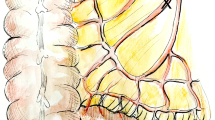Abstract
Purpose
There is no standard anastomosis technique for performing reconstruction after right hemicolectomy, and, in the literature, studies on ileocolonic anastomosis are rare. The aim of this retrospective work was to analyze the type of anastomosis techniques used and the related results in a multicentric enquiry.
Methods
A questionnaire was sent to the departments of surgery covering a 1.8 million inhabitant area to collect data concerning the anastomosis techniques used and the results related to complications.
Results
Data for 999 patients from 14 departments of surgery were collected. 95.8 % of the patients were affected by cancer and 4.2 % were affected by inflammatory bowel disease (IBD). The positioning of the anastomosing bowel was side-to-side in 60.5 % of the patients, end-to-side (E–S) in 38.1 % of the patients and end-to-end in 1.3 % of the patients. 46.4 % of the anastomoses were handsewn and 53.6 % were stapled. The complication rate in the cancer group was 5.1 % for handsewn techniques and 4.7 % for stapled techniques. The rate of anastomotic leakage was higher in the handsewn group than that in the stapled group (P < 0.05). The data for the IBD group were not statistically relevant.
Conclusions
This wide multicentric retrospective analysis showed that there remains variability in ileocolonic anastomosis techniques. Stapled anastomoses are associated with a lower incidence of leakage. In stapled anastomoses, the E–S configuration is also related to a lower incidence of leakage.
Similar content being viewed by others
References
Simillis C, Purkayastha S, Yamamoto T, Strong SA, Darzi AW, Tekkis PP. A metanalysis comparing conventional end-to-end anastomosis vs other anastomotic configurations after resection in Crohn’s disease. Dis Colon Rectum. 2007;50:1674–87.
Resegotti A, Astegiano M, Farina EC, Ciccone G, Avagnina G, Giustetto A, et al. Side-to-side stapled anastomosis strongly reduces anastomotic leakage rates in Crohn’s disease surgery. Dis Colon Rectum. 2005;48:464–8.
Kracht M, Hay JM, Fagniez PL, Fingerhut A. Ileocolonic anastomosis after right hemicolectomy for carcinoma: stapled or hand-sewn? A prospective, multicenter, randomized trial. Int J Colorectal Dis. 1993;8:29–33.
Yamamoto T, Bain IM, Allan RN, Keighley MRB. Stapled functional end-to-end anastomosis versus sutured end-to-end anastomosis after ileocolonic resection in Crohn disease. Scand J Gastroenterol. 1999;34:708–13.
Munoz-Juarez M, Yamamoto T, Wolff BG, Keighley MRB. Wide-lumen stapled anastomosis vs conventional en-to-end anastomosis in the treatment of Crohn’s disease. Dis Colon Rectum. 2001;44:20–6.
Anwar S, Hughes S, Eadie AJ, Scott NA. Anastomotic technique and survival after right hemicolectomy for colorectal cancer. Surg J R Coll Surg Edinb Irel. 2004;2:277–80.
Choy PY, Bissett IP, Docherty JG, Parry BR, Merrie AE. Stapled versus handsewn methods for ileocolic anastomosis. Cochrane Database Syst Rev. 2007;18:CD004320.
Izbicki JR, Gawad KA, Quirrenbach S, Hosch SB, Breid V, Knoefel WT, et al. Can stapled anastomosis in visceral surgery still be justified? A prospective controlled randomized study of the cost-effectiveness of hand-sewn and stapled anastomosis. Chirurg. 1998;69:725–34.
Wolmark N, Gordon PH, Fisher B, Weiand S, Lerner H, Lawrence W, et al. A comparison of stapled and handsewn anastomosis in patients undergoing resection for Dukes B and C colorectal cancer. Dis Colon Rectum. 1986;29:344–50.
Acknowledgments
We acknowledge the contributions of the following physicians to provide data concerning their patients: General Surgery Hospital of Acireale—Head: Dr. Alfio Saggio; General Surgery Hospital of Biancavilla—Head: Dr Gaetano Caldarera; General Surgery Hospital of Bronte—Head: Dr Alfio Cinardi; General Surgery Cannizzaro Hospital Catania—Head: Prof. Lino Succi; Emergency Surgery Cannizzaro Hospital Catania—Head: Prof. Domenico Russello; Abdominal Surgery Humanitas Hospital Catania—Head: Dr. Sebastiano Mongiovì; General Surgery Morgagni Clinic Catania—Head: Prof. Sergio Castorina; Emergency Surgery Garibaldi Hospital Catania—Head: Prof. Luigi Piazza; General Surgery Policlinico Catania—Head: Prof. Antonio Di Cataldo; General Surgery Vittorio Emanuele Hospital Catania—Head: Prof. Diego Piazza; General Surgery Vittorio Emanuele Hospital Catania—Head: Prof. Stefano Puleo; General Surgery Hospital of Lentini—Head: Prof. Giovanni Trombatore; Surgical Oncology Hospital of Taormina- Head: Dr. Vincenzo Panebianco; General Surgery Hospital of Vittoria, Ragusa—Head: Prof. Vincenzo Minutolo.
Conflict of interest
Stefano Puleo and the other co-authors have no conflicts of interest to declare.
Author information
Authors and Affiliations
Corresponding author
Rights and permissions
About this article
Cite this article
Puleo, S., Sofia, M., Trovato, M.A. et al. Ileocolonic anastomosis: preferred techniques in 999 patients. A multicentric study. Surg Today 43, 1145–1149 (2013). https://doi.org/10.1007/s00595-012-0381-8
Received:
Accepted:
Published:
Issue Date:
DOI: https://doi.org/10.1007/s00595-012-0381-8




